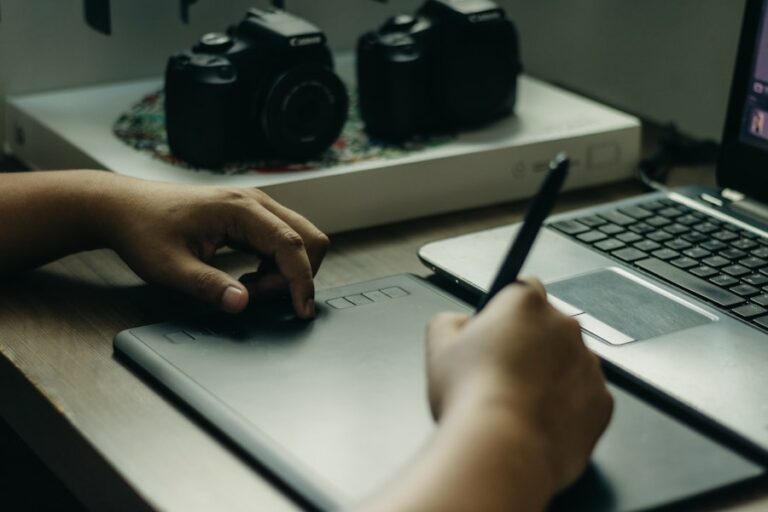From Sketch to Screen: The Ultimate Guide to Digitizing Your Artwork
Digitizing artwork is the process of converting traditional artwork, such as paintings, drawings, and sketches, into a digital format. This allows artists to easily share and showcase their work online, as well as make prints and merchandise. The first step in digitizing artwork is to understand the basics of the process. This includes knowing the different tools and software available for digitization, as well as the best practices for preparing and converting your artwork.
Digitizing artwork can be done using a variety of tools and software, including scanners, cameras, and graphic design programs. Each method has its own advantages and disadvantages, so it’s important to choose the right tools for your specific needs. Additionally, understanding the technical aspects of digitization, such as resolution, file formats, and color profiles, is crucial for producing high-quality digital artwork. By familiarizing yourself with these basics, you can ensure that your digitized artwork looks as close to the original as possible.
Choosing the Right Tools and Software for Digitizing
When it comes to digitizing artwork, choosing the right tools and software is crucial for achieving the best results. For scanning artwork, a high-quality flatbed scanner is often the best option, as it can capture fine details and accurate colors. If you don’t have access to a scanner, a digital camera with a high-resolution sensor can also be used to photograph your artwork. When it comes to software, Adobe Photoshop is a popular choice for editing and enhancing digitized artwork, while Adobe Illustrator is great for converting hand-drawn illustrations into vector graphics.
In addition to scanners and cameras, there are also specialized tools available for digitizing specific types of artwork. For example, there are pen tablets and styluses designed for digital drawing and painting, as well as 3D scanners for capturing sculptures and other three-dimensional artwork. By choosing the right tools and software for your specific needs, you can ensure that your digitized artwork looks professional and true to the original.
Preparing Your Artwork for Digitization
Before you can digitize your artwork, it’s important to properly prepare it for the process. This includes cleaning and flattening any physical artwork, as well as ensuring that it is well-lit and free from glare when being scanned or photographed. For paintings and other textured artwork, it may be necessary to use a high-resolution camera to capture the details accurately. Additionally, if you plan on editing your digitized artwork later on, it’s important to make sure that the original is in good condition and free from any imperfections.
In some cases, you may also need to make adjustments to your artwork before digitizing it. This could include cropping out any unwanted background or adjusting the levels and colors to match the original as closely as possible. By taking the time to properly prepare your artwork for digitization, you can ensure that the final result is of the highest quality.
Scanning and Photographing Your Artwork
Once your artwork is properly prepared, it’s time to scan or photograph it to create a digital version. When scanning artwork, it’s important to use a high-quality flatbed scanner with a high resolution to capture fine details and accurate colors. It’s also important to ensure that the artwork is placed flat on the scanner bed and that the scanner glass is clean to avoid any imperfections in the final digital image.
If you’re using a digital camera to photograph your artwork, it’s important to use a tripod to ensure that the camera is stable and that the artwork is well-lit. It’s also important to use a high-resolution camera with a good lens to capture fine details accurately. Additionally, using natural light or diffused artificial light can help avoid glare and reflections on the artwork.
Converting Your Artwork to Digital Format
Once you have scanned or photographed your artwork, the next step is to convert it into a digital format. For scanned artwork, this typically involves saving the image as a high-resolution file in a format such as TIFF or PSD. For photographed artwork, it may be necessary to adjust the levels and colors in a program like Adobe Photoshop to match the original as closely as possible.
If you’re working with hand-drawn illustrations or sketches, you may also need to convert them into vector graphics using a program like Adobe Illustrator. This allows you to scale your artwork without losing quality and make adjustments to individual elements easily. By converting your artwork into a digital format, you can easily edit and enhance it without losing any quality.
Editing and Enhancing Your Digitized Artwork
Once your artwork is in a digital format, you can begin editing and enhancing it to improve its appearance or make adjustments. This could include adjusting the levels and colors to match the original as closely as possible, removing imperfections or blemishes, or adding effects and filters to enhance the overall look of the artwork.
In addition to basic editing, you may also want to consider adding text or other elements to your digitized artwork to create promotional materials or merchandise. This could include adding your signature or logo, creating posters or prints, or designing merchandise such as t-shirts or mugs. By editing and enhancing your digitized artwork, you can create professional-looking pieces that are ready to be shared and showcased.
Sharing and Showcasing Your Digitized Artwork
Once your digitized artwork is complete, it’s time to share and showcase it online or in person. This could include creating an online portfolio or website to display your work, sharing it on social media platforms such as Instagram or Facebook, or participating in art shows and exhibitions. Additionally, you may also want to consider selling prints or merchandise featuring your digitized artwork through online marketplaces or at local events.
By sharing and showcasing your digitized artwork, you can reach a wider audience and potentially attract new clients or customers. It’s also a great way to connect with other artists and art enthusiasts who may be interested in your work. Whether you’re an established artist looking to expand your reach or an emerging artist looking to build a following, sharing and showcasing your digitized artwork is an essential part of the process.





